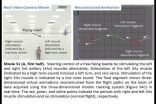(Press-News.org) A Venezuelan evolutionary biologist and a US zoologist state that they have refuted, through mitochondrial DNA sequencing, a recent claim, also based on such sequencing, that unknown type of bear must exist. in the Himalayas and that it may be, at least in part, the source of yeti legends. Their study was published in the open access journal ZooKeys.
Last year, B. Sykes and co-authors, in the course of mitochondrial DNA sequencing identification of hair samples that had been attributed to "anomalous primates" (yetis, bigfoots, and others), claimed to have found that two samples said to have come from the Himalayas had a 100% match with DNA recovered from a fossil Polar Bear from over 40,000 years ago. On this basis, they concluded that a currently unknown type of bear must inhabit that portion of Asia.
Later, however, it was shown by C.J. Edwards and R. Barnett that the sample that matched Sykes and co-authors' Himalayan ones, was in fact, from a present-day Polar Bear from Alaska, not from a fossil, and they hypothesized that the genetic material in the samples attributed to an unknown type of bear might have been misleading because of degradation.
Sykes and co-authors, however, have continued to maintain that their Himalayan samples must be from an unknown type of bear -- a claim that has received a good deal of attention from the media.
However, further analysis by Eliécer E. Gutiérrez, currently a postdoctoral fellow at the Smithsonian Institution, and Ronald H. Pine, affiliated with the Biodiversity Institute & Natural History Museum at the University of Kansas, have concluded that the relevant genetic variation in Brown Bears makes it impossible to assign, with certainty, Sykes and co-authors' samples to either that species or the Polar Bear.
In fact, because of genetic overlap, the samples could have come from either one. Because Brown Bears occur in the Himalayas, Gutiérrez and Pine state that therefore there is no reason to believe that the samples in question came from anything other than ordinary Himalayan Brown Bears.
As part of their study, Gutiérrez and Pine examined how the gene sequences analyzed might show the ways in which six present-day species of bears, including the Polar Bear and the Brown Bear; and the extinct Eurasian Cave Bear; might be related.
The results were partly in agreement with past studies but were also showing some new insights. The data set resulting from studying this part of the bears' genomes seems to be insufficient to make any definitive decisions as to what are the existing relationships on the basis of it alone. In combination with the results of other studies, however, it may very well prove quite useful in making such decisions.
Interestingly, it was found that one sequence from an Asian Black Bear from Japan indicated that it was not closely related to the mainland members of that species. This unexpected large evolutionary distance between these two geographic groups of the Asian Black Bear probably deserves further study.
"In fact, a study looking at the genetic and morphological variability of Asian Black Bear populations throughout the geographic distribution of the species is yet to be conducted, and it would surely yield exciting results," Gutiérrez said.
INFORMATION:
Original source
Gutiérrez EE, Pine RH (2015) No need to replace an "anomalous" primate (Primates) with an "anomalous" bear (Carnivora, Ursidae). ZooKeys 487: 141-154. doi: 10.3897/zookeys.487.9176
Berkeley -- Hard-wiring beetles for radio-controlled flight turns out to be a fitting way to learn more about their biology. Cyborg insect research led by engineers at the University of California, Berkeley, and Singapore's Nanyang Technological University (NTU) is enabling new revelations about a muscle used by beetles for finely graded turns.
By strapping tiny computers and wireless radios onto the backs of giant flower beetles and recording neuromuscular data as the bugs flew untethered, scientists determined that a muscle known for controlling the folding of wings ...
In the face of global climate change, increasing the use of renewable energy resources is one of the most urgent challenges facing the world. Further development of one resource, solar energy, is complicated by the need to find space for solar power-generating equipment without significantly altering the surrounding environment.
New work from Carnegie's Rebecca R. Hernandez (now at University of California Berkley), Madison K. Hoffacker, and Chris Field found that the amount of energy that could be generated from solar equipment constructed on and around existing infrastructure ...
Northwestern University scientists have developed a robust new material, inspired by biological catalysts, that is extraordinarily effective at destroying toxic nerve agents that are a threat around the globe. First used 100 years ago during World War I, deadly chemical weapons continue to be a challenge to combat.
The material, a zirconium-based metal-organic framework (MOF), degrades in minutes one of the most toxic chemical agents known to mankind: Soman (GD), a more toxic relative of sarin. Computer simulations show the MOF should be effective against other easy-to-make ...
"Warmer air transports more moisture and hence produces more precipitation - in cold Antarctica this takes the form of snowfall," lead author Katja Frieler from the Potsdam Institute for Climate Impact Research (PIK) explains. "We have now pulled a number of various lines of evidence together and find a very consistent result: Temperature increase means more snowfall on Antarctica," says Frieler. "For every degree of regional warming, snowfall increases by about 5 percent." Published in the journal Nature Climate Change, the scientists' work builds on high-quality ice-core ...
Researchers have discovered a valley underneath East Antarctica's most rapidly-changing glacier that delivers warm water to the base of the ice, causing significant melting.
The intrusion of warm ocean water is accelerating melting and thinning of Totten Glacier, which at 65 kilometres long and 30 kilometres wide contains enough ice to raise global sea levels by 3.5 metres. The glacier is one of the major outlets for the East Antarctic Ice Sheet, which is the largest mass of ice on Earth and covers 98 percent of the continent.
Climate change is raising the temperature ...
CORVALLIS, Ore. - A new study confirms that snowfall in Antarctica will increase significantly as the planet warms, offsetting future sea level rise from other sources - but the effect will not be nearly as strong as many scientists previously anticipated because of other, physical processes.
That means that many computer models may be underestimating the amount and rate of sea level rise if they had projected more significant impact from Antarctic snow.
Results of the study, which was funded by the National Science Foundation, were reported this week in the journal ...
About one quarter of the global seafloor is extremely nutrient poor. Contrary to previous assumptions, it contains oxygen not just in the thin surface layer, but also throughout its entire thickness. The underlying basement rocks contain oxygen as well. An international research team made these new discoveries through analysis of drill cores from the South Pacific Gyre.
In the latest issue of Nature Geoscience the scientists also point out the potential effects on the composition of Earth's interior because oxygen-containing deep-sea sediment has a different mineral composition ...
The underlying mechanism behind an enigmatic process called "singlet exciton fission", which could enable the development of significantly more powerful solar cells, has been identified by scientists in a new study.
The process is only known to happen in certain materials, and occurs when they absorb light. As the light particles come into contact with electrons within the material, the electrons are excited by the light, and the resulting "excited state" splits into two.
If singlet exciton fission can be controlled and incorporated into solar cells, it has the potential ...
Climbing rats, seabirds and tropical gophers are among the 15 animal species that are at the absolute greatest risk of becoming extinct very soon. Expertise and money is needed to save them and other highly threatened species.
A new study shows that a subset of highly threatened species - in this case 841 - can be saved from extinction for about $1.3 billion a year. However, for 15 of them the chances of conservation success are really low.
The study published in Current Biology concludes that a subset of 841 endangered animal species can be saved, but only if conservation ...
New heart imaging technology to diagnose coronary heart disease and other heart disorders is significantly more accurate, less expensive and safer than traditional methods, according to a new study by researchers from the Intermountain Medical Center Heart Institute in Salt Lake City.
Researchers at the Intermountain Medical Center Heart Institute compared Single Photon Emission Computed Tomography (SPECT), currently the most commonly used imaging diagnostic tool, with a new imaging technology -- coronary-specific Positron Emission Tomography (cardiac PET/CT).
They ...


